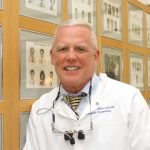Donor Profile: Dr. William Mason, an upbeat adjunct and mentor who gives back to his alma mater12 min read
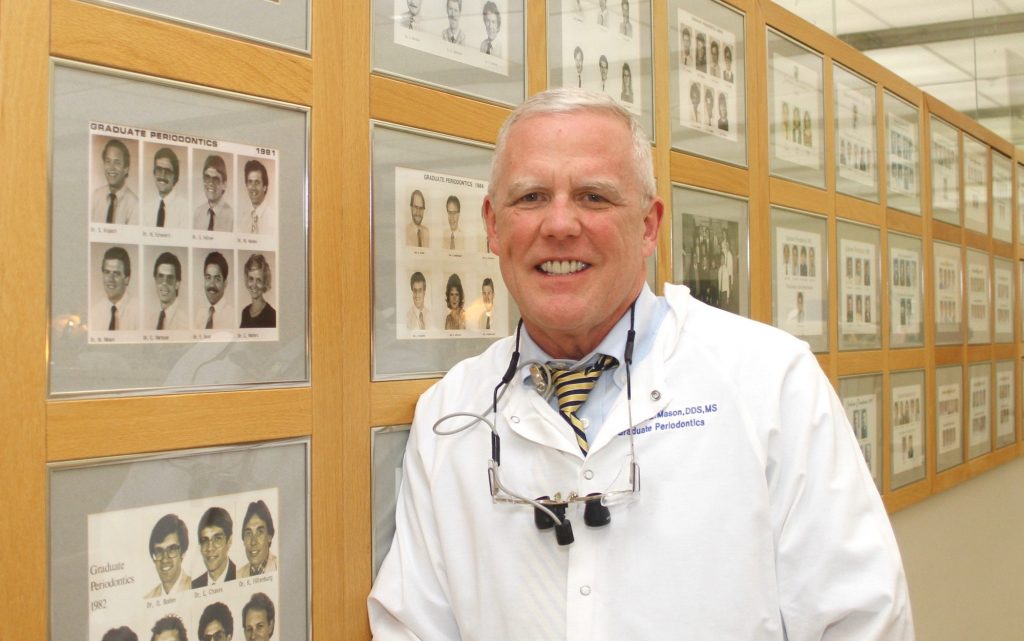
Dr. William Mason is about to step out of the Graduate Periodontics Clinic briefly when the resident in the operatory closest to the door asks if she can talk to him.
Mason breaks off his route to the door and steps over to the side of the cubicle, leans in over the chest-high panel and begins listening intently to the resident’s questions. It is the start of a 10-minute, back-and-forth conversation full of dental terminology about treatment options for a patient the resident had just examined.
They discuss various techniques to cover an exposed root surface next to a missing tooth. Would a “pedicle graft” or a “free graft” be better in this case? Mason and the resident, Dr. Nathalia Andrade, contribute equally to the conversation. A pedicle graft moves tissue from an adjacent area to cover the root surface, thus maintaining blood supply. A free graft borrows tissue from the roof of the patient’s mouth, but that creates two surgical sites for the patient. Since the patient is on blood-thinning medication, one site would be preferred since it would create less post-operative bleeding.
At one point in the discussion, Mason moves into the treatment cubicle in order to examine the digital image of the patient’s mouth on a computer screen. He points to various places on the image as he describes his experience in handling cases like this. Although Mason is an adjunct faculty member who has been a periodontist for 35 years, he treats the conversation with Andrade as though he is talking to a long-time colleague rather than a less-experienced dentist. He is earnest and friendly, alternately smiling and turning serious as he gestures to mimic how he would position his hands during the surgical procedures they are talking about. By the end of the conversation, faculty member and resident are in agreement and confident that they have determined the best approach for treating the patient at a return appointment in a few weeks.
Mason’s collegial approach to teaching comes both naturally – his default personality setting is “genuinely nice guy” – and because he remembers what worked for him when he was a dental student, including time as a graduate resident like Andrade in this very same periodontics clinic. “Being an upbeat instructor allows for a more effective exchange of ideas and therefore more successful learning,” he says. “A negative approach causes the students to shut down, stop listening and puts them in a defensive mindset.”
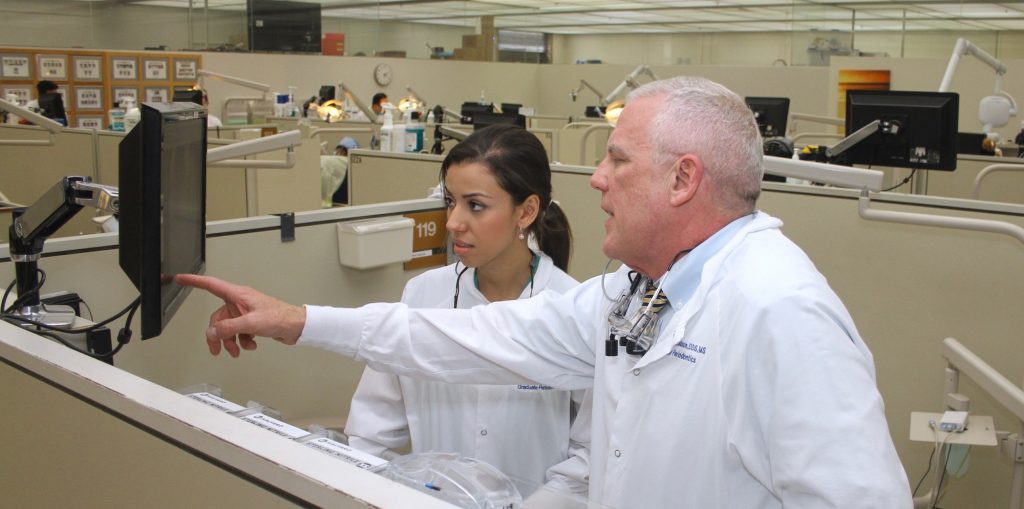
He has a lot to share after treating thousands of patients over 35 years. “I find it very rewarding to offer my clinical experience,” Mason said. “I’ve seen a lot of patients with a lot of different conditions, so I can offer that to the residents here who haven’t seen as much. I try not to be dictatorial. I want them to think and tell me what they see as the best approach. And I always learn from them, too, because there are really smart students here at the dental school.”
Mason was one of those students beginning in 1977, following the career path of his grandfather, William J.B. Mason, who earned his DDS from U-M in 1918. Mason originally considered medicine, but the 24-7 schedule of his father, a pediatrician (and also a U-M grad), was not what he wanted in a career. He started his undergrad studies at U-M in mechanical engineering, but switched to a pre-dental science curriculum for his final two years, deciding that he would follow his grandfather’s career choice after all.
Mason earned his DDS in 1981 and his MS in periodontics in 1984. He took the three-year master’s option (most students did the two-year plan), teaching in the undergraduate clinic while earning his MS by completing and publishing an original clinical research project. Once he completed his specialty training, he had not planned to return to his hometown of Saginaw, Mich., but the retirement there of his early dentistry mentor, Dr. Billy Smith, provided an opportunity for Mason to start a periodontal practice.
Saginaw has been a good place to practice, Mason says, but not without some difficult times. During the 1990s, General Motors laid off workers and closed factories, which also affected auto supply companies and other businesses, leading to the loss of paychecks and health insurance for thousands of people in the region around Saginaw and nearby Flint. “Seventy percent of my patients worked at General Motors and didn’t have any insurance,” he said. “We were concerned: What are we going to do? We survived.”
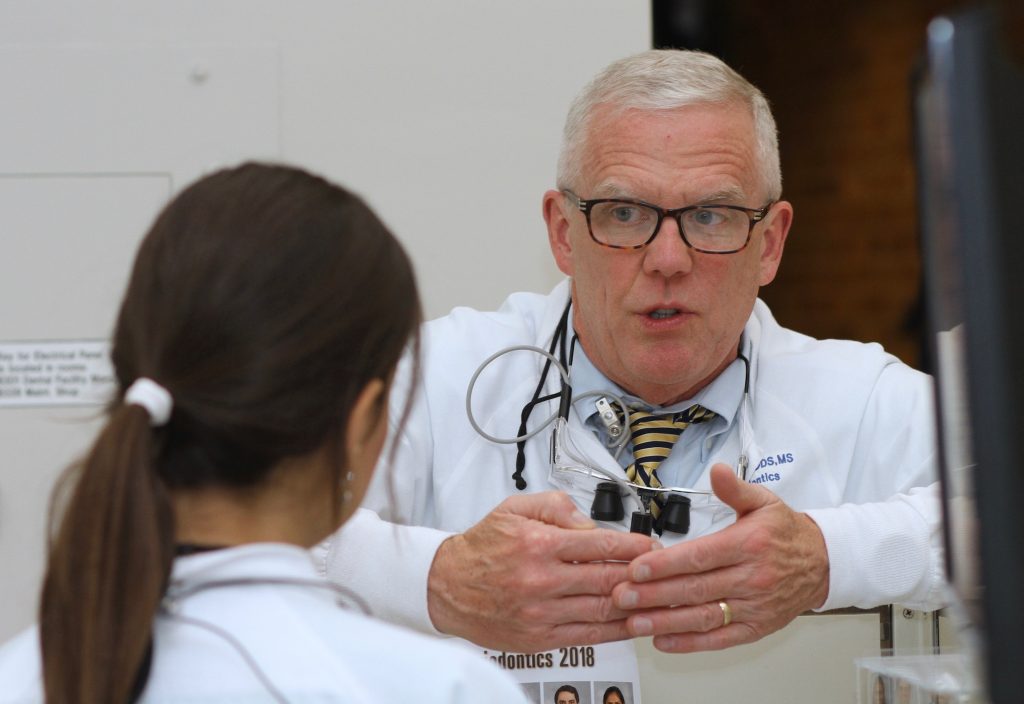
Calling on his “glass is half full” philosophy, Mason and his staff moved forward. The practice’s client base has grown over the years to include a wide region, from Mt. Pleasant to the northwest and the Thumb area of the state to the northeast. “There are a lot of outlying areas we draw from so I get to know farmers and inner-city patients and everyone in between. It’s been fun, the patients are interesting. Some people don’t want to go back to their hometown, but Saginaw has been really good to me.”
Among his community service endeavors is an annual perio surgery demonstration for students in the dental hygiene program at Delta College. He and his associate, Dr. Monica Lamble, take two patients to the college and set up a video camera that projects views of the surgeries so that about 25 students can watch the operation in real time. Each year, Mason also has offered an evening of continuing education to referring offices for continuing education credit. “I try to stick to the basics of periodontics and implant dentistry, while presenting some new information I feel is timely and current.” Mason has written and published 11 articles in various journals, including eight in the Journal of the Michigan Dental Association. He is also a member of the Pierre Fauchard Society.
Mason is among the periodontists who adopted implants as a significant portion of their practice after the procedure came to North America from Europe in the late 1980s. He initially wasn’t interested, but a mentor, Dr. Frank Rugani of Saginaw, encouraged him to take courses and add the treatment to his practice. Today, after performing close to 5,000 implants he is glad Rugani insisted.
Another unique part of Mason’s dentistry portfolio is his fascination with developing instruments to solve technical problems, the same interest that led him to mechanical engineering his first two years of college. About 15 years ago, working with local tool-and-die makers, Mason developed and patented a device that dentists can use to lessen pain for a patient who receives an anesthetic injection in the roof of their mouth. His Palatal Anesthesia Device, or PAD, is a dental instrument with a small C-shaped end that is pressed against the patient’s palate before the needle is inserted in the center of the C. The pressure against the palate reduces the pain associated with the initial needle penetration. The pressure technique is not new, but previously the most common option for dentists was to use the handle of a dental mirror or other instrument to apply the pressure. Mason figured there must be a better way and invented one.
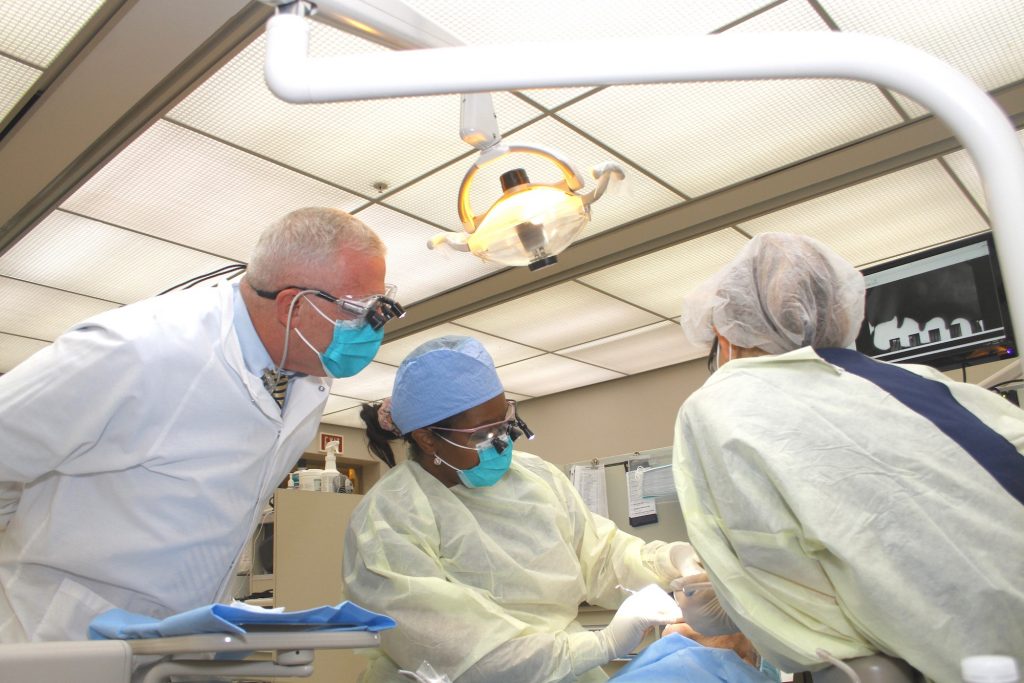
Two more dentistry-related inventions have followed. The Mirror Buddy is a silicon pad that fits on a dental mirror handle, just above the mirror, so that the dentist doesn’t pinch the patient’s cheek during exams and treatment. The silicon is medical grade so that it can be autoclaved. Calling on a need he discovered in his work with implants, Mason created the Stretch Implant Driver, which extends the length of the instrument used to remove and replace cover screws and healing abutments when working with implants. It allows dentists to work without their fingers obstructing their view.
The PAD is offered for sale in the catalog of Salvin Dental Specialties and Mason sells all three devices on his website, masterdentalonline.com. His patent on the PAD has expired, but he says the projects haven’t been about making money. “I love doing stuff like this. I’ve met a lot of people, it’s been fun,” he says. “But it’s hard to get it done. I probably had 30 prototypes. I look at other types of products now – even something as simple as a pen – and think about how hard it must have been to test and develop.” Undeterred by the process, he says he may try to develop a few more of his ideas.
Besides tinkering with inventions in his free time, Mason and his wife, Ann, are avid snow skiers and Masters ski racers. They ski and compete most weekends during the winter with a large group of friends and family at Nub’s Nob, near their second home in Harbor Springs, Mich., and enjoy mountain skiing out West every year. In the summer, they play tennis and Bill water skis competitively. He is a blue belt in Brazilian jiu-jitsu, which he practices once a week with a group of friends.
Even with all of those diversions, Mason is never far from dentistry. He takes pride in working five days a week. “I feel like I need to be productive every day and that’s why I work every day, including Friday,” he said. “When I sometimes take Fridays off I almost feel guilty because I could be working. That may sound silly, but I just feel like I have something to offer people and I want to offer it as long as I can. The best part is just taking care of my patients and making sure they get what they need. I feel that I need to take care of them.”
That devotion to dentistry has been passed on to his two daughters. Dr. Suzanne Mason, who earned her MS in perio at the U-M dental school, practices in Traverse City, and Dr. Chelsea Mason practices general dentistry in Bay City.
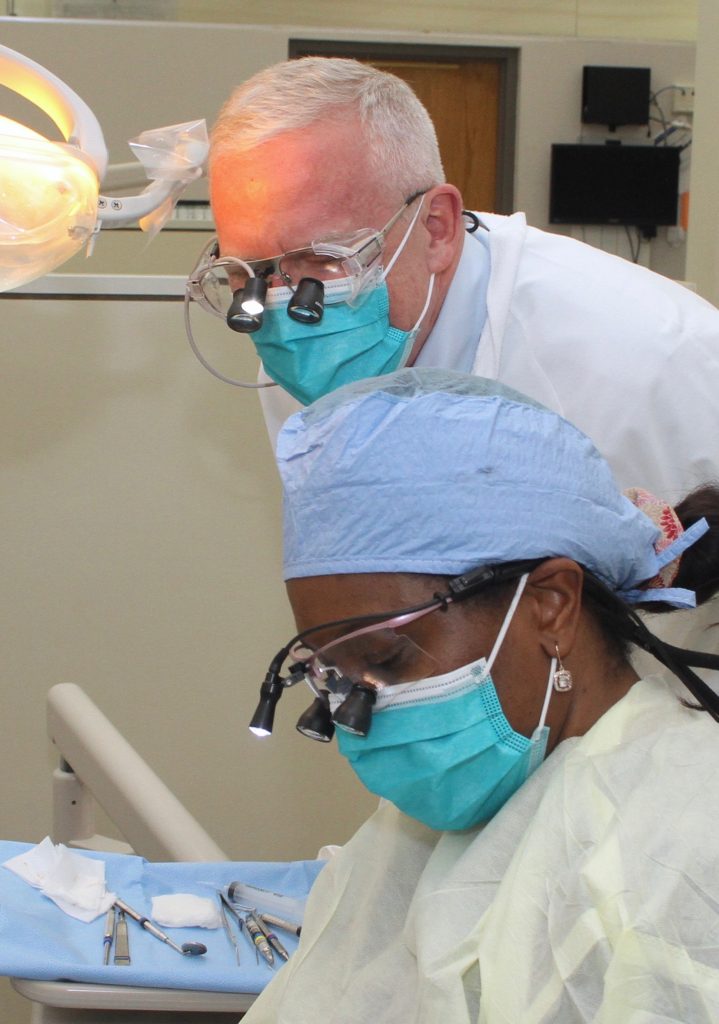
About 15 years ago, Mason decided to return to the School of Dentistry as an adjunct faculty member. It is a way to give back to the school where he earned two degrees and launched a successful career, and where his daughter Suzanne and grandfather also advanced their education. One day a month, he makes the pre-dawn drive from Saginaw to Ann Arbor to serve on the Dean’s Faculty as an Adjunct Clinical Assistant Professor in the Department of Periodontics and Oral Medicine. He spends a long day working with residents and patients in the Grad Perio Clinic, then returns to Saginaw that evening feeling that he has gained as much as he gave.
More recently, he decided on another way to contribute to the ongoing success of the school. He and his wife made a financial gift of $75,000. He’s still considering whether to designate a scholarship or help fund clinic improvements as part of the major Blue Renew renovation project now underway at the school. Mason said he had considered a gift for a number of years and the idea was reinforced a few years ago when, during the Ramfjord Symposium, the school announced a gift from Dr. Jeffery Johnston (DDS 1982, MS perio 1986).
Mason remembers Johnston telling the audience, “The rest of you should think about donating like I have. Come on, step up and think about it.” It was an effective testimonial. “This school has done so much for me,” Mason said. “I get so much out of coming here. I really enjoy it. I remembered what Jeff said and decided I was going to do that, too. The school is a great place and if I can afford to give something back, that’s good. This school just means a lot to me.”
###
The University of Michigan School of Dentistry is one of the nation’s leading dental schools engaged in oral health care education, research, patient care and community service. General dental care clinics and specialty clinics providing advanced treatment enable the school to offer dental services and programs to patients throughout Michigan. Classroom and clinic instruction prepare future dentists, dental specialists and dental hygienists for practice in private offices, hospitals, academia and public agencies. Research seeks to discover and apply new knowledge that can help patients worldwide. For more information about the School of Dentistry, visit us on the Web at: www.dent.umich.edu. Contact: Lynn Monson, associate director of communications, at [email protected], or (734) 615-1971.

